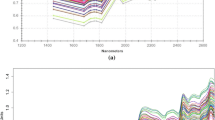Abstract
An energy dispersive X-ray fluorescence (ED-XRF) spectrometer and a near infrared (NIR) spectrometer combined with chemometrics were applied for origin discrimination of 48 Korean, 44 Chinese, and 21 Indian sesame seed samples used for development of a discriminant calibration model. Multi-elemental ED-XRF analysis based on Mg, Al, Si, P, S, Cl, K, Ca, Mn, Fe, and Cu was used for comparisons among origins. All elements, except for Fe, showed differences and 96.5% of seed samples were assigned to the correct origin using discriminant analysis based on chemical analytical results. NIR measurements were performed for spectral scanning. Classification of seeds using NIR discriminant analysis achieved 89.4% of seed samples assigned to the correct origin. Both ED-XRF and NIR are useful as nondestructive tools for discrimination of sesame seed origins.
Similar content being viewed by others
References
Korea’s Ministry of Food and Drug Safety. Available from: www. foodsafetykorea.go.kr. Accessed Jun. 15, 2015.
Ministry of Agriculture, Food and Rural Affairs. Statistical of imported agriculture, forestry and livestock. Available from: www.atfis.or.kr. Food information statistics system. Accessed Jun. 15, 2015.
Korea’s Ministry of Food and Drug Safety. Imported food information. Available from: www. foodnara.go.kr/importfood/src/ statistics/item_list.jsp. Accessed Jun. 15, 2015.
Shim KB, Hwang C K, Pae S B, Lee M H, Ha TJ, Park CH. Comparision of physiochemical characters of sesame seeds according to the different producing origin. J. Korean Soc. Int. Agric. 22: 371–375 (2010)
Kelly S, Heaton K. Tracing the geographical origin of food: The application of multi-element and multi-isotope analysis. Trends Food Sci. Tech. 16: 557–567 (2005)
Anderson KA, Smith BW. Effect of season and variety on the differentiation of geographic growing origin of pistachios by stable isotope profiling. J. Agr. Food Chem. 54: 1747–1752 (2006)
Camaro AB, Sara R, Eduardo JM, Juan ML. Use of the Argentinean garlic (Allium Sativum L.) germplasm mineral profile for determining geographic origin. J. Food Compos. Anal. 23: 586–591 (2010)
Rummel S, Hoelzl S, Horn P, Rossmann A, Schlicht C. The combination of stable isotope abundance ratios of H, C, N and S with 87Sr/86Sr for geographical origin assignment of orange juices. Food Chem. 118: 890–900 (2010)
Ariyama K, Shinozaki M, Kawasaki A. Determination of the geographic origin of rice by chemometrics with strontium and lead isotope ratios and multielement concentrations. J. Agr. Food Chem. 60: 1628–1634 (2012)
Yan J, Liu J, Xiong Y, Qin W, Tang C. Identification of the geographical origins of pomelos using multielement fingerprinting. J. Food Sci. 80: C228–C233 (2015)
Galgano F, Favat F, Carugo M, Scarpa T, Palma A. Analysis of trace elements in southern Italian wines and their classification according to provenance. LWTFood Sci. Technol. 41: 1808–1815 (2008)
Liou HC, You CF, Chen CY, Liu YC, Chung MT. Geographic determination of coffee beans using multi-element analysis and isotope ratios of boron and strontium. Food Chem. 142: 439–445 (2014)
Bong YS, Song BY, Gautam MK, Jang CS, An HJ, Lee KS. Discrimination of the geographic origin of cabbage. Food Control 30: 626–630 (2013)
Vitale R, Bevilacqua M, Bucci R, Magri AD, Magri AL, Marini F. A rapid and noninvasive method for authenticating the origin of pistachio samples by NIR spectroscopy and chemometrics. Chemometr. Intell. Lab. 121: 90–99 (2013)
Galtier O, Dupuy N, Dreau YL, Ollivier D, Pinatel C, Kister J, Artaud J. Geographic origins and compositions of virgin olive oils determined by chemometric analysis of NIR spectra. Anal. Chim. Acta 595: 136–144 (2007)
Lin H, Zhao J, Chen Q, Zhou F, Sun L. Discrinination of radix pseudostellae according to geographical origins using NIR spectroscopy and support vector data description. Spectrochim. Acta A 79: 1381–1385 (2011)
Otaka A, Hokura A, Nakai I. Determination of trace elements in soybean by Xray fluorescence analysis and its application to identification of their production area. Food Chem. 147: 318–326 (2014)
Marques AF, Queralt I, Carvalho ML, Bordalo M. Total reflection X-ray fluorescence and energy-dispersive X-ray fluorescence analysis of runoff water and vegetation from abandoned mining of Pb-Zn ores. Spectrochim. Acta B 58: 2191–2198 (2003)
Woo YA, Kim HJ, Ze KR, Chung H. Near-Infrared(NIR) spectroscopy for the nondestructive and fast determination of geographical origin of Angelicae Gigantis Radix. J. Pharmaceut. Biomed. 36: 955–959 (2005)
Mezghani LS, Vanloot P, Molinet J, Duppy N, Hammami M, Kamoun NG, Artaud J. Authentication of Tunisian virgin olive oils by chemometric analysis of fatty acid compositions and NIR spectra. Comparision with Maghrebian and French virgin olive oils. Food Chem. 173: 122–132 (2015)
Xu L, Yan SM, Cai CB, Zhong W, Yu XP. Rapid analysis of geographical origins and age of Torreya Grandis seeds by NIR spectroscopy and pattern recognition methods. J. Spectrosc. Article ID 468509 (2013)
Margui E, Queralt I, Hidalgo M. Application of X-ray fluorescence spectrometry to determination and quantitation of metals in vegetal material. Trends Analyt. Chem. 28: 362–372 (2009)
Jeon HJ, Lee SC, Cho YJ, Oh JH, Kwon KS, Kim BH. A triple-isotope approach for discriminating the geographic origin of asian sesame oils. Food Chem. 167: 363–369 (2015)
Yang BH. Understanding Multivariate Data Analysis. 4thed. Communication Books Inc., Seoul, Korea. pp. 107–124 (2011)
Han KJ. Application of SPSS Statistical research. Baeksan Publisher, Seoul, Korea. pp. 381–432 (2012)
Xu Z, Liu Y, Li X, Cai W, Show X. Discriminant analysis of Chinese patent medicines based on near-infrared spectroscopy and principal component discriminant transformation. Spectrochim. Acta A 149: 985–990 (2015)
He Y, Li X, Deng X. Discrimination of varieties of tea using near infrared spectroscopy by principal component analysis and BP model. J. Food Eng. 79: 1238–1242 (2007)
Author information
Authors and Affiliations
Corresponding author
Rights and permissions
About this article
Cite this article
Choi, Y.H., Hong, C.K., Park, G.Y. et al. A nondestructive approach for discrimination of the origin of sesame seeds using ED-XRF and NIR spectrometry with chemometrics. Food Sci Biotechnol 25, 433–438 (2016). https://doi.org/10.1007/s10068-016-0059-x
Received:
Revised:
Accepted:
Published:
Issue Date:
DOI: https://doi.org/10.1007/s10068-016-0059-x




